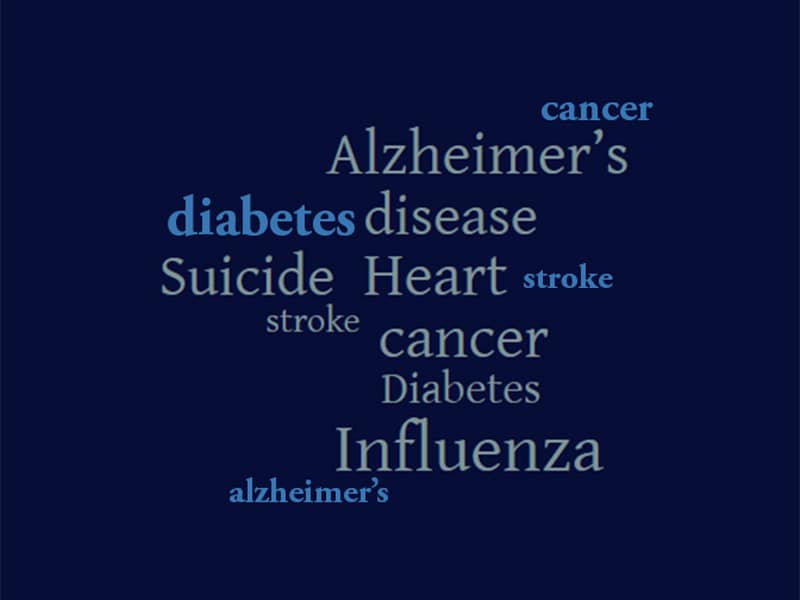Of note, Immunization, Obesity, Illiteracy and High School drop out are actual priorities worldwide!
After several years of this policy, the CDC decided to evaluate its impact. In 1964, Alexander Langmuir, MD, MPH, then the chief epidemiologist at the CDC, published a paper[13] that "reluctantly concluded that there is little progress to be reported. The severity of the epidemic of 1962-1963...demonstrates the failure to achieve effective control of excess mortality." The paper questioned whether widespread influenza immunization "should be continued without better evidence to justify the major costs to the general public." Despite this, annual vaccination campaigns were continued.
In 1968, the CDC finally performed a randomized, double-blind trial[14] to examine the effect of vaccination on morbidity and mortality. The authors concluded that "Despite extensive use of influenza vaccines...attainment of [improved morbidity and mortality] has never been demonstrated." Nevertheless, flu immunization continued.
In 1976, H1N1 "swine flu" appeared, and a large-scale effort to immunize as many Americans as possible was launched.[15] However, the anticipated levels of disease did not appear, and an epidemic of paralytic Guillain-Barré syndrome in recipients of vaccine led to the program's cancellation. An analysis in 1977[16] by the CDC concluded that influenza control had been "generally ineffective" and that statistically valid community trials were needed.
In 1995, a major review from the US Food and Drug Administration acknowledged the ongoing "paucity of randomized trials" and warned about serious methodological flaws in many existing flu vaccine studies.[17]
In 2000, the CDC performed a placebo-controlled trial and found that "vaccination [when compared to placebo] may not provide overall economic benefit in most years."[18]
Nonetheless, in 2004, the AAP recommended annual influenza immunization for young children, household contacts, and healthcare providers.[19]
Vaccination coverage recommendations continued to expand, and now during every flu season, we watch commercials by retail pharmacies telling us about the importance of getting the flu shot. The fact that the AAP recommends "mandatory" flu vaccination for healthcare providers[20] means that eventually clinicians could be fired for not getting vaccinated.
Despite the lack of high-quality data supporting the value of the flu shot, widespread vaccination policy might still be reasonable if observational studies consistently showed a benefit. However, the observational studies cited by flu shot proponents are frequently flawed.[22-28] In many studies, relevant clinical outcomes are ignored in favor of immunogenicity (ie, the ability to elicit an antibody response). "Influenza-like illness" (ie, cold symptoms) is frequently measured instead of serious outcomes, such as pneumonia or death. When these more serious outcomes are examined, there is often a failure to control for healthy user bias—the propensity for healthier people to do such things as receive annual check-ups, eat healthier foods, and get the flu shot. So, although it's true that people who get flu shots live longer, it may have nothing to do with actually getting the flu shot.
A 2005 study of a 33-season, national data set attempted to reconcile the reduced all-cause morbidity and mortality found in some observational studies of influenza vaccination with the fact that "national influenza mortality rates among seniors increased in the 1980s and 1990s as the senior vaccination coverage quadrupled."[29] In this study, the authors conclude that:
We are pediatricians, and we believe in childhood immunizations. Many vaccines have provided immense public health value. We simply question whether the policy of routine influenza vaccination has outpaced the data supporting its use.
Influenza vaccination now supersedes many other priorities of public health (such as obesity, illiteracy, and high school dropout), and we question whether so much time, effort, and money should be dedicated to flu vaccination while these other national healthcare priorities remain on the back burner.
Flu Vaccine for All: A Critical Look at the Evidence
|
Related Drugs & Diseases
When Vaccination Became Routine
Vaccine proponents felt that the failure of the vaccine was explained by the immunization campaign being too little, too late. As a result, in 1960, national health experts recommended, for the first time, routine annual vaccination, with emphasis on high-risk groups, including those over the age of 65 years and individuals with chronic illness.[13] By the early 1960s, routine influenza vaccination was generally adopted as a policy, with very little supporting evidence.After several years of this policy, the CDC decided to evaluate its impact. In 1964, Alexander Langmuir, MD, MPH, then the chief epidemiologist at the CDC, published a paper[13] that "reluctantly concluded that there is little progress to be reported. The severity of the epidemic of 1962-1963...demonstrates the failure to achieve effective control of excess mortality." The paper questioned whether widespread influenza immunization "should be continued without better evidence to justify the major costs to the general public." Despite this, annual vaccination campaigns were continued.
In 1968, the CDC finally performed a randomized, double-blind trial[14] to examine the effect of vaccination on morbidity and mortality. The authors concluded that "Despite extensive use of influenza vaccines...attainment of [improved morbidity and mortality] has never been demonstrated." Nevertheless, flu immunization continued.
In 1976, H1N1 "swine flu" appeared, and a large-scale effort to immunize as many Americans as possible was launched.[15] However, the anticipated levels of disease did not appear, and an epidemic of paralytic Guillain-Barré syndrome in recipients of vaccine led to the program's cancellation. An analysis in 1977[16] by the CDC concluded that influenza control had been "generally ineffective" and that statistically valid community trials were needed.
In 1995, a major review from the US Food and Drug Administration acknowledged the ongoing "paucity of randomized trials" and warned about serious methodological flaws in many existing flu vaccine studies.[17]
In 2000, the CDC performed a placebo-controlled trial and found that "vaccination [when compared to placebo] may not provide overall economic benefit in most years."[18]
Nonetheless, in 2004, the AAP recommended annual influenza immunization for young children, household contacts, and healthcare providers.[19]
Vaccination coverage recommendations continued to expand, and now during every flu season, we watch commercials by retail pharmacies telling us about the importance of getting the flu shot. The fact that the AAP recommends "mandatory" flu vaccination for healthcare providers[20] means that eventually clinicians could be fired for not getting vaccinated.
Summing Up the Data
A 2012 systematic review and meta-analysis[21] examined the efficacy and effectiveness of licensed influenza vaccines in patients with confirmed influenza illness. The authors confirmed that the original "recommendation to vaccinate the elderly was made without data for vaccine efficacy or effectiveness." The main message was that we need a better vaccine and better studies to demonstrate its effectiveness.Despite the lack of high-quality data supporting the value of the flu shot, widespread vaccination policy might still be reasonable if observational studies consistently showed a benefit. However, the observational studies cited by flu shot proponents are frequently flawed.[22-28] In many studies, relevant clinical outcomes are ignored in favor of immunogenicity (ie, the ability to elicit an antibody response). "Influenza-like illness" (ie, cold symptoms) is frequently measured instead of serious outcomes, such as pneumonia or death. When these more serious outcomes are examined, there is often a failure to control for healthy user bias—the propensity for healthier people to do such things as receive annual check-ups, eat healthier foods, and get the flu shot. So, although it's true that people who get flu shots live longer, it may have nothing to do with actually getting the flu shot.
A 2005 study of a 33-season, national data set attempted to reconcile the reduced all-cause morbidity and mortality found in some observational studies of influenza vaccination with the fact that "national influenza mortality rates among seniors increased in the 1980s and 1990s as the senior vaccination coverage quadrupled."[29] In this study, the authors conclude that:
"[Our] estimates, which provide the best available national estimates of the fraction of all winter deaths that are specifically attributable to influenza, show that the observational studies must overstate the mortality benefits of the vaccine...[even during two pandemic seasons] the estimated influenza-related mortality was probably very close to what would have occurred had no vaccine been available."The rationale for flu immunization as a national health priority is that influenza is a disease with serious complications, such as pneumonia, hospitalization, and death.[5,13,28] If the reason for influenza vaccination is that flu is such a serious disease, then the relevant outcomes are whether vaccination improves morbidity and mortality from flu. However, after decades of vaccine use, it is hard to detect any public health impact. This is in stark contrast to other routine vaccinations, such as polio and Haemophilus influenzae type b, where introduction of the vaccine led to obvious decline of the disease.
We are pediatricians, and we believe in childhood immunizations. Many vaccines have provided immense public health value. We simply question whether the policy of routine influenza vaccination has outpaced the data supporting its use.
Influenza vaccination now supersedes many other priorities of public health (such as obesity, illiteracy, and high school dropout), and we question whether so much time, effort, and money should be dedicated to flu vaccination while these other national healthcare priorities remain on the back burner.


















